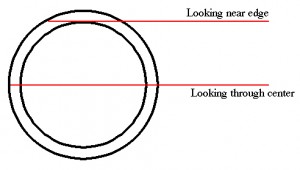I don’t get a chance very often to combine two previous posts, but I was thinking recently about planetary nebulae – winds of gas blown off by dying stars – and remembered my very favorite one in the whole sky, Abell 39:
[Click to ennebulenate.]
Isn’t that awesome? It’s like it’s right out of Star Trek. I’ve written about the giant haloes surrounding some planetary nebulae before, and also about why some objects look like smoke rings. In a (nut)shell, as a star like the Sun begins its long, slow path to dying, it expands into a red giant and blows off a thick wind of matter. This material expands spherically in most cases, streaming off in all directions into space and forming what’s called a giant outer halo.
 In most planetaries (like the famous Cat’s Eye nebula, and the less famous but also cool NGC 6826) the outer halo slams into material floating in interstellar space, causing it to get all clumpy or form a bright rim as the surrounding matter gets plowed up. But the rim around Abell 39 isn’t like that; while it’s bright, it’s actually an illusion! Near the edge, we are seeing through more material than we are through the center, and that would be true no matter from what direction we see the nebula. That makes the outer edge look brighter than the inner parts, giving the nebula the appearance of a vast, eerie smoke ring.
In most planetaries (like the famous Cat’s Eye nebula, and the less famous but also cool NGC 6826) the outer halo slams into material floating in interstellar space, causing it to get all clumpy or form a bright rim as the surrounding matter gets plowed up. But the rim around Abell 39 isn’t like that; while it’s bright, it’s actually an illusion! Near the edge, we are seeing through more material than we are through the center, and that would be true no matter from what direction we see the nebula. That makes the outer edge look brighter than the inner parts, giving the nebula the appearance of a vast, eerie smoke ring.
It’s pretty rare to get such a near-perfect circle of gas from a planetary nebula, and to be honest Abell 39 is one of only a very few I’m aware of. One reason it’s so perfect is that it’s located well above the plane of the galaxy. Down here, in that plane, there’s copious gas and dust. But Abell 39 is well away from all that, so its expanding red giant wind can retain its almost exactly spherical shape.
It’s also huge: 5 - 6 light years across, which is twice as large or more than most other planetaries, implying it’s old. Given the expansion velocity and size, it must be 20,000 years old or so. It’s also 7000 light years way, so it’s fairly faint, making it a rare target for amateur astronomers… though not unknown.
Readers with a keen eye might have noticed the star in the middle is a bit off-center. No one knows why. I’d love to see a telescope like Hubble or Gemini North get a deep view of this smoke ring. Why is the star misplaced? Why is the limb on the lower left brighter than on the right? Plus, the hint of detail in this image would be greatly enhanced in a deeper exposure, and that would really be incredible to see.
Image credit: WIYN/NOAO/NSF
Related posts:
- The knotty Cat’s Eye halo
- A delicately violent celestial shell game
- A star on the edge of a weird, lovely death
- The beginning of the end for a star